Hey Entrepreneur,
This week, we’re switching things up a bit. Don’t worry you’ll still get a few quick wins but I want to take you behind the curtain a little and show you what’s really happening inside my business as I grow DB Impact.
One of the best lessons I’ve learned over the years is to ask for feedback and not just listen to it, but actually apply it. When I first started this newsletter, I asked a few people in my life to share their honest thoughts each week.
Recently, one of my new clients (from our data and lead generation division at DB Impact) gave me some of the best advice I’ve gotten yet:
“You should put more of you, Drew Roberts, into your newsletters.”
So that’s exactly what this week’s issue is about.
Quick Recap: This Week’s Newsletter in 2 Minutes
If you’d rather watch than read, here’s the short version. I cover the core idea behind this week’s topic—why doing things manually first can save you time and money later.

Where I’ve Been Focusing Lately
Over the last few weeks, I’ve been intentionally zeroing in on the activities I need to be doing consistently: emails, social posts, client follow-ups, and general communication. You know, all the things required to actually run a business effectively in today’s world.
But because I’m me, I needed a plan. First, I had to identify what those activities were. Then, I had to actually execute them.
But because I’m me, I needed a plan. First, I had to identify what those activities were. Then, I had to actually execute them.
But because I’m me, I needed a plan. First, I had to identify what those activities were. Then, I had to actually execute them.
Now, some people would immediately jump to automating everything. But from experience, I’ve learned that it’s often smarter to do something manually first to understand the process, find the friction points, and learn what “good” looks like before letting software take over.
When you automate too soon, you risk missing blind spots or worse, over-automating and making things more complicated than they need to be.
So today, I’m going to walk you through a real example of one of my recent activity projects, and exactly how I implemented it.

The LinkedIn Outreach Project
Over the last 14 years, I’ve built up a network of more than 11,000 LinkedIn connections. And I realized recently that I was doing a terrible job of staying connected. Out of those 11,000 professionals, 99.9% probably have no idea what I do or how I could help them.
Step 1: Identify the Opportunity
I saw a huge gap between the network I had and the communication I was actually doing.
Step 2: Define the Goals
Goal 1: Clearly communicate the services I offer and connect with people interested in an exploratory call.
Goal 2: Close new business.
Step 3: Execute Manually First
Before jumping into automation, I wanted to test my outreach manually. I needed to experiment with different message styles, track response rates, and get a feel for what was actually resonating.
For two weeks, I committed to sending 150 personalized messages per week to people in my network introducing myself, sharing what I do, and starting genuine conversations.
By the end of the two weeks, I had sent 300 messages, gathered valuable feedback, and identified which messages worked and which ones didn’t.
Step 4: Automate the Right Way
Once I had clarity on my process, I started looking for a software solution that could handle the heavy lifting while saving me time. My goal was to reduce my manual effort from 100% to 10% to go from spending four hours per week to about forty minutes.
After researching several platforms, I landed on LinkedHelper2.
There are plenty of shiny, advanced tools out there, but I went back to my original goal to effectively reach my network and create meaningful conversations. LinkedHelper2 offered exactly what I needed without unnecessary complexity or cost.
If you’re considering testing it for your own outreach, they gave me a promo code for 10% off your first purchase:
https://www.linkedhelper.com/?lhpc=LHU-I0YQFB4B6KN2LSDTNDGJGQ

The Takeaway
In today’s world of technology, it’s easy to get caught up in “shiny object syndrome.” There’s always a new tool, app, or AI promising to save you time but automation without strategy is just noise.
Here’s what I’ve learned:
Do it manually first. Learn the process inside and out.
Fix the inefficiencies. Identify the holes and improve the workflow.
Then automate. Once you know exactly what works, find a tool that handles 80% of the process for you.
This approach might take more time upfront, but it saves you money, frustration, and wasted effort down the road. You’ll know exactly what you need and avoid buying five different tools that don’t actually solve your real problem.
Interested in Creating Your Own Beehive Newsletter?
Use this link and get 20% off for your first three months: https://www.beehiiv.com?via=Drew-Roberts



